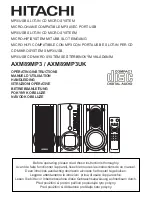
L & R (Main) MASTER SEND Faders and CLIP LEDs
The left & right main summing bus receives signals directly from the channel faders, as well as the
three
L&R
RETURN LEVELS
controls.
CLIP LED
s fire a few
dB
lower from actual clipping so some
activity is allowable. Signal routing goes from the master faders (to
STEREO EQ
)… and to the
SPEAKER
PROCESSOR.
Then, to both the
L&R LINE LEVEL OUTPUTS
and the normally closed switching lugs on
the
AMP A&B INPUT
jacks – thereafter to amps
A&B.
(At the same time, the
post
-master signal goes
directly to the
RECORD
outputs, bypassing the
EQ
, processor, etc.)
The
CLIP LED
s are unlikely to fire as this stage of the mixer has a large amount of headroom.
However, if one, or both
LEDs
become very active (small amounts of activity are
OK
), check the
RETURN
LEVELS CLIP LED
s and reduce the settings of any
L&R RETURN
master/s in channels showing clipping.
The
L&R
masters regulate the level of the main stereo mix available at the
RECORD
outputs (no
main
EQ
). and the
L&R LINE LEVEL OUTPUTS
. They also regulate the amplifier
A&B
power output lev-
els (unless another mixer has been patched into the
AMP A&B INPUTS
in which case
its
masters will
determine power output).
Speaker Processor Curve and ENABLE Buttons
The
POWERMAX
features a choice of two low-frequency boost curves centred at
50Hz
and
80Hz
and
selectable via the
CURVE
button. The
50Hz
curve has a high
Q
factor for subwoofers while the
80Hz
curve
is slightly broader and better suited for full range cabinets. An
ENABLE
,
ON-OFF
button is also provided.
It is advisable to use this feature judiciously. For example you would probably
not
want to boost the main
L/R EQ’
s low frequencies while it is enabled. On the other hand, it can add valuable depth to the speaker
system. Experiment with it during a sound check. In case of low-frequency feedback, simply put the
ENABLE
button to the
OFF
position.
L/R Main EQ
This is a stereo 9-band
EQ
on the output of the
main bus. Range is
+/-12dB
with centers at one-
octave intervals from
63Hz
to
16kHz
.
The main
EQ
would most often be set dur-
ing a sound check and used to carefully adjust
main speaker response (no radical boosts). It is
also useful for curbing feedback tendancies, but
remember that
monitors
most often cause your
feedback problems. Naturally, monitor feedback
comes out the main
PA
too which, when you are
out front at the mixer station, leads to the illusion
that the main system needs
EQ
ing. See under
MON1
and
MON2 EQ’
s
for more about this.
When setting the main
EQ
, do not automati-
cally go to a
smiling
curve as with a home stereo
– which will cost your system both headroom and
gain before feedback. Initially, keep the
EQ
curve
as close to flat (all sliders at center) as possible,
then make necessary adjustments as required dur-
ing the sound check to cut feedback frequencies.
MON1 & MON2 EQs
These are 9-band mono
EQ’s
with
+/-12dB
on the
same centers as the
L/R
MAIN EQ
. They are inserted
between the monitor buses and the # 3 & 4 power
amps, also the
MON1 & 2 LINE LEVEL OUTPUTS
.
These
EQ’s
should be set flat (all sliders at
center) then adjusted for minimal monitor feed-
back during a sound check. If feedback does set
in during the job, you will be tempted to blame
the mains because that’s what you hear from the
mixing station out front. Don’t be misled. As a rule
it’s one or more of the monitors, but of course the
noise comes out the mains too. Use your channel
MUTE
buttons to mute each channel briefly and
see if the noise stops. You may also use the
CLIP
LED
s to hunt for feedback channels. If the chan-
nel
GAIN
s are set high enough per instructions,
feedback channels will have increased
CLIP
light
Summary of Contents for POWERMAX 1622
Page 1: ...OWNER S MANUAL MANUEL de L UTILISATEUR Y orkville OWNER S MANUAL MODEL TYPE YS1011 ...
Page 13: ...11 ...
Page 27: ...25 ...
Page 32: ...30 ...











































